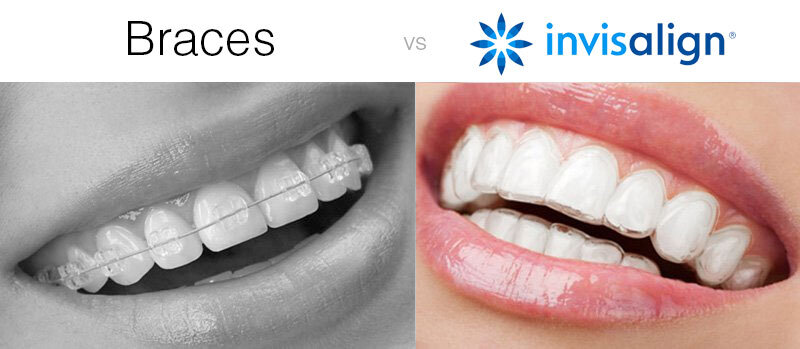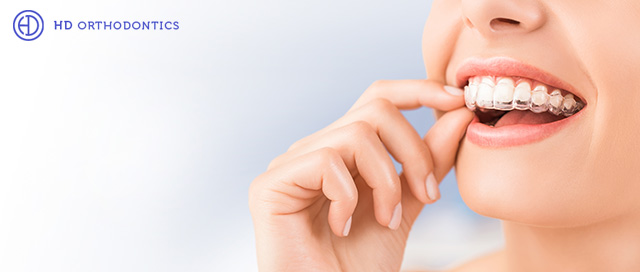How Invisalign Functions: Your Overview to Clear Aligners and Their Effectiveness
Invisalign vs. Traditional Braces: Which Option Is Right for You?
When taking into consideration orthodontic therapy, the choice between Invisalign and conventional braces provides a number of crucial variables that warrant careful assessment. Invisalign provides a very discreet option with detachable aligners, while standard dental braces give an extra noticeable yet effective solution for severe misalignment. Each option encompasses distinct benefits and drawbacks associated with appearances, convenience, therapy duration, and expense. Recognizing these nuances is critical for making a notified decision that aligns with your individual choices and way of life. The question remains: which alternative will ideal satisfy your orthodontic demands and assumptions?
Review of Therapy Choices

In comparison, traditional braces contain metal brackets and cords that are bonded to the teeth. This approach applies continuous pressure in time to accomplish placement. While reliable for complex orthodontic issues, traditional braces call for normal sees for modifications and can position challenges in preserving dental health as a result of the difficulty of cleaning up around brackets and wires.
Both choices have their qualities, and the option commonly depends upon details dental conditions, lifestyle preferences, and patient conformity. Inevitably, speaking with an orthodontic specialist is essential for figuring out the most ideal treatment plan customized to specific needs. Comprehending the nuances of each choice can significantly influence the total success of orthodontic therapy.
Aesthetic Factors To Consider
A considerable element influencing the option in between Invisalign and standard dental braces is the aesthetic charm each therapy supplies. Invisalign aligners are crafted from clear plastic, making them virtually undetectable when put on. This very discreet appearance is particularly appealing to grownups and teenagers who might feel uncomfortable regarding their orthodontic therapy. The ability to preserve a natural smile throughout the positioning process can substantially improve the client's self-confidence in professional and social settings.
In contrast, typical braces consist of metal brackets and cables, which can be a lot more recognizable. While developments in orthodontic innovation have caused the growth of smaller sized brackets and tinted elastics, standard braces still keep an even more noticeable profile. For some individuals, the presence of dental braces might discourage them from seeking required treatment.
Inevitably, the option between Invisalign and typical dental braces might depend upon personal choices pertaining to looks. Patients that focus on discretion commonly lean towards Invisalign, while those who are less concerned concerning visibility may select traditional braces. Understanding the aesthetic effects of each choice is essential for making a notified decision that straightens with one's way of living and preferences.
Convenience and Convenience

In terms of benefit, Invisalign aligners are detachable, enabling individuals to enjoy their favored foods without constraint and preserve optimal oral hygiene. Brushing and flossing are simplified, as the aligners can be taken out throughout these routines, whereas traditional dental braces call for cautious steering around brackets and cords.
Furthermore, Invisalign's dynamic system allows for fewer orthodontic check outs. Patients usually obtain multiple collections of aligners at once, which can enhance the therapy procedure and minimize time spent in the orthodontist's chair. In comparison, standard dental braces demand regular adjustments, making them less hassle-free Bonuses for those with active timetables. Invisalign. Overall, the convenience and benefit of Invisalign make it an enticing option for lots of individuals seeking orthodontic therapy.
Treatment Period and Performance
While both Invisalign and traditional braces are effective in remedying dental misalignments, the duration of treatment can differ substantially between both alternatives. Generally, Invisalign therapy can take anywhere from 12 to 18 months, depending upon the complexity of the instance. The clear aligners work by gradually changing teeth into their wanted settings, and routine follow-ups with an orthodontist assistance ensure progress continues to be on course.
On the other hand, traditional braces commonly need a longer dedication, normally varying from 18 months to 3 years. This results from their set nature and using braces and cords, which can be a lot more efficient for complicated situations and serious misalignments (Invisalign). The treatment effectiveness of conventional braces is well-documented, as they permit precise adjustments and better control over tooth movement
Ultimately, the selection in between Invisalign and typical dental braces may depend upon both the anticipated therapy duration and the particular dental concerns available. Consulting with an orthodontist is important, as they can offer tailored referrals based upon individual needs, ensuring the picked technique aligns with wanted results and timeframes.
Cost Contrast and Insurance Coverage Choices
Price plays a substantial function in the decision-making process for people thinking about orthodontic treatment, whether deciding for Invisalign or standard dental braces. Generally, the cost of Invisalign arrays from $3,000 to $8,000, while standard braces normally cost in between $2,000 and $6,000. Elements affecting these expenses consist of the complexity of the case, the duration of therapy, and geographical location.
Insurance policy coverage can dramatically affect out-of-pocket expenditures. Numerous oral insurance strategies provide partial insurance coverage for orthodontic treatments, however the specifics can differ widely. It is critical for clients to assess their insurance plan to determine the level of coverage for either choice. Usually, conventional dental braces might be much more regularly covered by insurance strategies contrasted to Invisalign, which some insurance companies classify as a cosmetic procedure.
Furthermore, a number of orthodontic techniques supply adaptable settlement strategies, making both therapy options more available. Individuals must make inquiries concerning potential financing options and discounts for upfront payments. Evaluating the total cost, consisting of insurance benefits and layaway plan, is essential for making an informed decision that aligns with both visual choices and spending plan factors to consider.

Verdict
In recap, the selection between Invisalign and conventional braces hinges on multiple variables, consisting of visual choices, comfort, treatment duration, and price. Invisalign supplies a very discreet, removable option that helps with oral health and nutritional versatility, while standard braces might be Check This Out preferable for complicated dental issues and often come with a reduced cost factor. Inevitably, examination with an orthodontist is important to assess individual conditions and figure out the most ideal treatment alternative for accomplishing optimal oral positioning.
When thinking about orthodontic therapy, the option between Invisalign and traditional dental braces presents numerous essential variables that merit mindful examination.Comparing Invisalign and standard braces exposes distinctive treatment alternatives for orthodontic adjustment.While both Invisalign and typical braces are reliable in fixing oral misalignments, the period of therapy can vary significantly between the 2 options.Expense plays a significant function in the decision-making procedure for individuals taking into consideration orthodontic treatment, whether deciding for Invisalign or traditional braces.In recap, the choice between Invisalign and traditional braces pivots on numerous elements, consisting of visual preferences, convenience, treatment period, and expense.